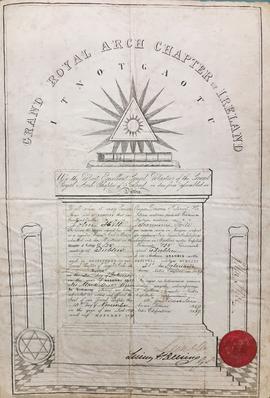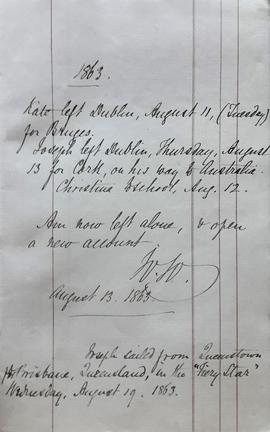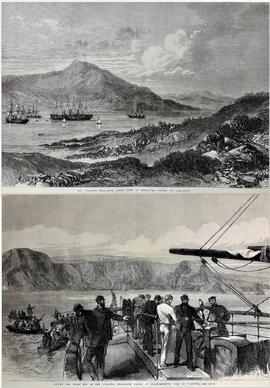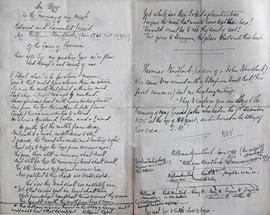Woodlock Family History Scrapbook
- IE CA CP/3/7/1
- Dossier
- 1843-1946
Fait partie de Irish Capuchin Archives
A bound volume containing pasted-in correspondence, photographs, newspaper clippings and ephemera relating to various members of the Woodlock family. It is likely that Fr. Senan Moynihan OFM Cap. compiled the volume from loose letters and records he had acquired. The contents are diverse and relate to very many members (and generations) of the Woodlock family. The volume includes:
• A transcript of ‘An elegy to the memory of my much beloved and lamented friend Mr William Woodlock (born 1741; died 1825) of the town of Roscrea’. The second page of the transcript has family history notes by William Woodlock (1832-1890), including a partial family tree which indicates that William Paul Woodlock was his great-grandfather. An additional entry notes that William Paul Woodlock (c.1780-1834) left Roscrea in 1798.
• A letter to Frances Woodlock from a religious sister in the Convent of the Sacred Heart in Melbourne, Australia. (18 January 1897).
• Memorial card for Anna Louisa Dillon (died 25 February 1916) and interred at the City of London Cemetery in Ilford, London.
• Photographic print. Manuscript caption reads ‘George / William Woodlock Aitken / Juan’.
• Copy letter from William Law, Treasury Chambers, to [William Woodlock] regarding the numbers of magistrates in the Police District of Dublin (16 March 1876).
• Photographic print of a Marist priest. Manuscript caption reads ‘The Rev. M. Cummins SM, St. Mary’s College, Dundalk, Sept. 1867’.
• Memorial card for Domhnall James O’Sullivan. ‘Born at Cork. October 12, 1866 / Died at Bruges Belgium November 1, 1884’.
• Manuscript text by William Woodlock titled ‘To the high-borne noble lady Elisabeth von Eichthal’.
• German text referring to Frances Mary Woodlock.
• Photographic print captioned ‘Arthur Woodlock Feb. 1875’.
• Letter to Frances [Woodlock] from Sister A. Hudson, Brighton. The letter mainly refers to family news. The letter is undated.
• Clipping of a letter from Sister J. Carroll RSC, Sacred Heart Convent, Newcastle-upon-Tyne, giving an account of a fire which destroyed the convent and adjoining school and her role in the rescue of all the children in her care. (12 February 1908).
• Copy marriage certificate of William Woodlock and Frances Dillon (4 February 1865). The certificate is extracted from the registry book of the Parish of St. Patrick, Cork. The copy was made on 18 December 1893.
• Card marking the fiftieth anniversary of the marriage of William [1801-1883] and Catherine Woodlock in Dublin on 13 May 1829. This William Woodlock was the father of William Woodlock (1832-1890), the barrister and Dublin Police Court Magistrate.
• Advertisement for a series of articles by Thomas F. Woodlock (1866-1945), the former editor of ‘The Wall Street Journal’. The articles were published by Columbia Press with the title of ‘The Catholic Mind and the Modern World’. (1946).
• Clipping of an article reporting on the funeral of William Woodlock. The article notes that Woodlock died on 12 June 1890 (aged 58). It reads ‘The remains of the late Mr. William Woodlock JP, one of the Divisional Police Magistrates of Dublin, were removed this morning from his residence, Mounty Square, for internment in Glasnevin Cemetery … the burial service was recited by the Most Rev. [Bartholomew] Woodlock, Bishop of Ardagh’. The article notes that Bishop Bartholomew Woodlock was William Woodlock’s uncle.
• Clippings of obituaries for Thomas F. Woodlock (1866-1945). The clippings are taken from ‘The Universe’, ‘The Times’ and ‘Irish Independent’. Reference is made to his Irish connections, noting that he was born in Dublin and that he was the elder brother of Fr. Francis Woodlock SJ (1871-1940) and a grandnephew of Bishop Bartholomew Woodlock (1819-1902).
• Notice re the funeral of Catherine Woodlock (née Teeling), who was born in Dublin on 14 June 1808 and who died in Bruges, Belgium, on 3 March 1885. Catherine Woodlock was the mother of William Woodlock (1832-1890), the barrister and Dublin Police Court Magistrate.
• Memorial card for William Woodlock ‘born in Dublin on 10 November 1801 and died in Bruges, Belgium, on 29 May 1883’. This William Woodlock was the father of William Woodlock (1832-1890), the barrister and Dublin Police Court Magistrate.
• Clipping of an article reporting the resignation of Bartholomew Woodlock as Bishop of Ardagh and Clonmacnoise (‘Irish Times’, 12 October 1894).
• Clipping of a short death notice for William Woodlock, ‘one of the Divisional Magistrates of Dublin’. (‘Irish Catholic’, June 1890).
• Photographic prints captioned ‘Christine Aitken and John Aitken’ and ‘F. W.’s Niece / Kathleen Aitken’.
• Correspondence of William Woodlock with his mother and father. (1843-1860). The letters refer to personal and family news and to the younger William’s travels in England and in Europe.
• Clipping of an article reporting on the death of Miss Mary Woodlock born in Dublin on 25 August 1841, and died in Port-of-Spain, Trinidad, on 30 August 1896. It is noted that Mary Woodlock was the niece of Bishop Bartholomew Woodlock (1819-1902). (‘The Catholic News’, Port-of-Spain, 4 September 1896).
• Clipping of an article by John O’Connor titled ‘Thomas F. Woodlock: Apostle of Truth’ (‘Ava Maria’, 12 Jan. 1946).
• Clipping of an obituary and appreciation for Ellen Woodlock (‘Cork Examiner’, 16 July 1884).
• Letter from Sir Dominic Corrigan (1802-1880), 4 Merrion Square West, Dublin, to ‘Fanny’ (possibly Frances Woodlock). (1 December 1872).
• Letter from William Corrigan, 13 Hardwick Place, Dublin, to Frances Dillon [his future wife], 7 Sidney Place, Cork. (13 September 1864).
• Photographic print of two women and their dog overlooking Bray Head in County Wicklow. No indication of the identities of the two women is given, but it is very likely that they are members of the extended Woodlock family. The railway line in the background of the photograph is the Bray to Greystones route, which first opened in 1855, and includes tunnels and viaducts designed by the British engineer Isambard Kingdom Brunel (1806-1859).
A loose letter is also extant in the file. The letter from William Woodlock is in German and is dated (at Blackrock, County Dublin) 16 April 1852.




